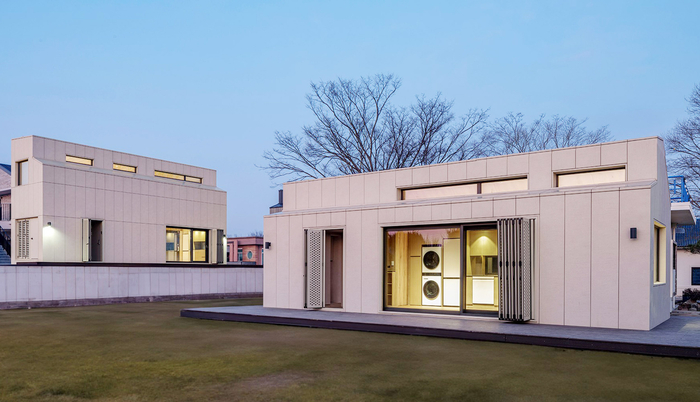Innovative Homes of 2040: A Glimpse into Futuristic Materials and Construction Processes
The home of 2040 will likely look similar to modern conventional houses of today but with the advances in materials science, automation, and sustainable technology the construction industry is undergoing today. New cutting-edge materials and processes are set to redefine how future homes will be built.

Next-Gen Materials: Strong, Sustainable, and Smart
Self-Healing Concrete
One of the key materials revolutionizing the construction industry is self-healing concrete. By 2040, this remarkable innovation will be a common feature in homes. Embedded with bacteria that produce limestone when exposed to water, self-healing concrete automatically repairs cracks, drastically extending the lifespan of a building. This reduces maintenance costs and increases sustainability, as fewer repairs mean fewer resources are required over time.
Graphene-Infused Composites
Graphene, a super-strong, lightweight material, is expected to play a significant role in future home construction. Its incredible properties—200 times stronger than steel, yet only a fraction of its weight—make it ideal for reinforcing structures. Homes built with graphene-infused composites will be not only stronger and more resilient to environmental stressors but also lighter, enabling the construction of larger, more open spaces with fewer support beams.
Carbon-Negative Materials
With an increasing focus on sustainability, homes of the future will likely be made from materials that actively reduce carbon emissions. Carbon-negative concrete and hempcrete, which absorb more carbon dioxide during their lifespan than is emitted during production, will be used in walls and foundations. This makes each home not just carbon-neutral but carbon-negative, contributing positively to the environment.

Automation and Robotics in Construction
3D Printing Entire Homes
3D printing technology will evolve to the point where entire homes can be printed on-site using advanced materials. Large-scale 3D printers will utilize a mixture of recycled plastics, bio-materials, and graphene to construct walls and foundational elements layer by layer. This process allows for highly customized home designs, reduced labor costs, and significantly faster construction times. A home that once took months to build could be erected in just days.
Modular Prefabrication and Robotics
Factories equipped with robotic arms and AI-driven processes will manufacture entire sections of homes, which will then be transported and assembled on-site. These prefabricated modules will include everything from walls and floors to electrical and plumbing systems, all pre-installed and tested. Robotics will handle the precision assembly of these components, ensuring flawless construction. This approach will minimize human error, reduce construction waste, and allow for mass production of customized homes.
Autonomous Construction Equipment
Construction sites will be transformed by fleets of autonomous drones, excavators, and bulldozers, all working together seamlessly. Using AI and real-time data, these machines will optimize construction processes, ensuring efficiency and safety. These technologies will drastically reduce the need for human labor on-site while increasing construction speed and accuracy.
Energy Efficiency and Smart Integration
Solar Skin and Transparent Solar Panels
In 2040, homes will be energy producers, not just consumers. Solar skin—thin, flexible solar cells that can be applied like paint to any surface—will power homes. In addition, transparent solar panels will replace traditional windows, harnessing solar energy while maintaining clear views. These materials will make homes virtually self-sufficient in energy, dramatically reducing reliance on external power grids.
Smart Building Envelopes
Futuristic homes will feature smart building envelopes that dynamically adjust their thermal properties. Using phase-change materials and embedded sensors, these envelopes will adapt to the climate, storing heat during the day and releasing it at night, or vice versa. By regulating temperature more effectively, homes will use less energy for heating and cooling, contributing to overall energy efficiency.
Integrated Energy Storage Systems
Instead of relying on bulky batteries, homes of 2040 will have energy storage systems integrated directly into their walls and foundations. These energy-storing materials, made from next-gen batteries like solid-state cells or flow batteries, will store excess energy generated by solar panels or wind turbines. This stored energy can be used to power the home when renewable sources aren’t available, making homes self-sustaining.
Sustainable Water and Waste Management
Water Recycling Systems
Water conservation will be a critical focus in the homes of the future. Advanced water recycling systems will purify greywater (from sinks, showers, and washing machines) and blackwater (from toilets) for reuse. These systems will be compact and seamlessly integrated into the home’s infrastructure, drastically reducing water waste. In combination with smart irrigation systems for landscaping, these homes will use a fraction of the water that current homes require.
Zero-Waste Construction
The construction industry will become a leader in sustainability by adopting zero-waste practices. With precision from robotics and 3D printing, material waste will be virtually eliminated. Leftover materials from one project will be repurposed or recycled for the next. Homes will also incorporate composting waste systems, transforming organic waste into energy or fertilizer, ensuring minimal impact on the environment.
.
AI-Driven Design and Personalization
AI-Powered Home Design
Architects will collaborate with AI to design homes tailored to individual preferences and environmental conditions. AI software will analyze a site’s climate, wind patterns, and solar exposure to create optimized designs that minimize energy consumption and enhance comfort. Homeowners will work with AI to choose personalized designs, materials, and even color schemes, ensuring every home is unique.
Customizable Modular Interiors
In addition to prefabricated exteriors, interiors will be fully modular and customizable. Homeowners will be able to modify room layouts and furniture configurations on demand using moveable walls and AI-controlled systems. This flexibility will allow homes to adapt to changing needs over time, from expanding living spaces to transforming rooms into offices or playrooms.
The homes of 2040 will be more than just shelters—they will be self-sufficient, sustainable, and intelligent ecosystems designed for both comfort and efficiency. With advanced materials like graphene and self-healing concrete, automation through 3D printing and robotics, and smart energy solutions, the future of home construction promises not only to enhance living standards but also to contribute to a healthier planet. The question is no longer if we will build these homes, but how soon we can begin.
.







